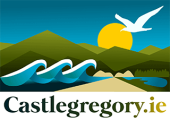 Lough Gill is a shallow lake with alkaline waters located on the western outskirts of Castlegregory in County Kerry. Its average depth is just 30 to 40cm and it is a metre at its deepest. It has a surface area of approximately 1.4 square kilometres, is 2.4 Kilometres long and 0.8 kilometres wide.
Lough Gill is a shallow lake with alkaline waters located on the western outskirts of Castlegregory in County Kerry. Its average depth is just 30 to 40cm and it is a metre at its deepest. It has a surface area of approximately 1.4 square kilometres, is 2.4 Kilometres long and 0.8 kilometres wide.
The Stradbally and Killiney rivers flow into the lake while its levels are controlled by a sluice which allows water out and into the nearby Tralee Bay and prevents salt water getting into the lake. Despite this, there are low levels of salt in the lake.Lough Gill is owned by the State. There is a cave located on the south western shore. Just north of Lough Gill is a continuous 14 kilometre stretch of strand which includes the beaches of Stradbally, Gowlane and Kilcumin and is the longest beach in Ireland.
On the shore of Lough Gill is the village of Castlegregory. This was the location of a castle which was built by Gregory Hoare in the 16th century, hence the village name. Tragedy surrounded the bare family. Gregory died at the castle in 1566 and his son Hugh also died at the very same spot in 1580.Sir Walter Raleigh was one of the castles famous guests. The castle has long been destroyed however an arched doorway from the castle can still be seen at tailor’s Row in the village.
Immediately South of Lough Gill is the Church of Ireland Church of Our Saviour. Within the grounds of this modern church are the Killiney stone cross, and the remains of a medieval church and tower. The stone cross is 2.86m high, half a metre wide and 20cm thick. It is made from sandstone dressed to a smooth finish on all sides.
The remains of a medieval church, which are in poor condition, can also be found. This was originally built in the 13th century and then entirely rebuilt in the l5th/l6th century. A residential tower was added to the southeast corner church in the 16th century.
There are two storey’s remaining but these are in very poor condition and completely covered with ivy. A bullaun Stone was discovered built into the wall of the churchyard is now on display in the grounds of the Roman Catholic Church in Castlegregory.
Stradbally is a tiny little village south west of Lough Gill. There was a church at Stradbally in the early 14th century but the present remains are probable from the 15th or 16th century. They consist of three walls of a rectangular building. The west wall is missing.The church measures about I6m by 6m internally . The ruin is greatly overgrown and many of the features mentioned in the Archaeological Survey are not immediately obvious. There is a good Pointed South doorway outside it; at ground level is a good holy water stoup.
Ireland’s only toad, the natterjack, can be found at Lough Gill. The very shallow waters suit the toad and Lough Gill is recognised as one of the most important areas for natterjacks in Ireland supporting about two thirds of Ireland’s breeding toads.
Lough Gill also attracts large numbers of swans annually It is one of the few places were Bewick’s. Mute and Whooper swans can all be seen. In 2010 a fish survey of the lake revealed six species present. The three-spined stickleback was the most numerous followed in order by sand goby, flounder, brown trout, European eel and thick lipped grey mullet.

CastlegregoryGolf course is situated between Lough Gill and Brandon Bay. Golfers on the course have brilliant views of Lough Gill. According to The Sportsman’s Holiday Guide 1897, a fine 18 hole golf course existed in the Castlegregory area – “about 3 ½ miles in circuit it lies along the coast and is quite the first course in the Kingdom of Kerry.”
With the development of a course in Tralee, this course fell into disuse. However, back in 1988, local man, Maurice Fitzgerald, who had long harboured a desire for a links course in the vicinity. He arranged for a general meeting of interested people. This was held in the Tralee Bay Hotel and the outcome of that meeting was the renting of 57.28 acres of land beside Lough Gill. Castlegregory Golf Club was reformed and has never looked back.


